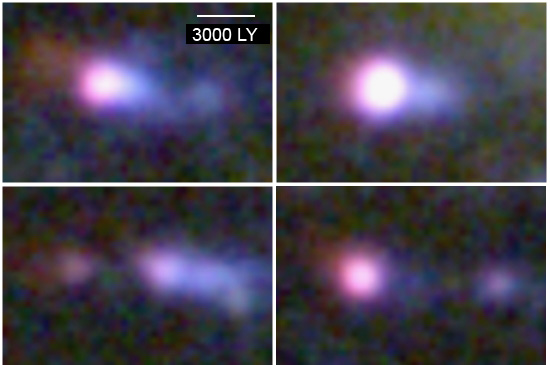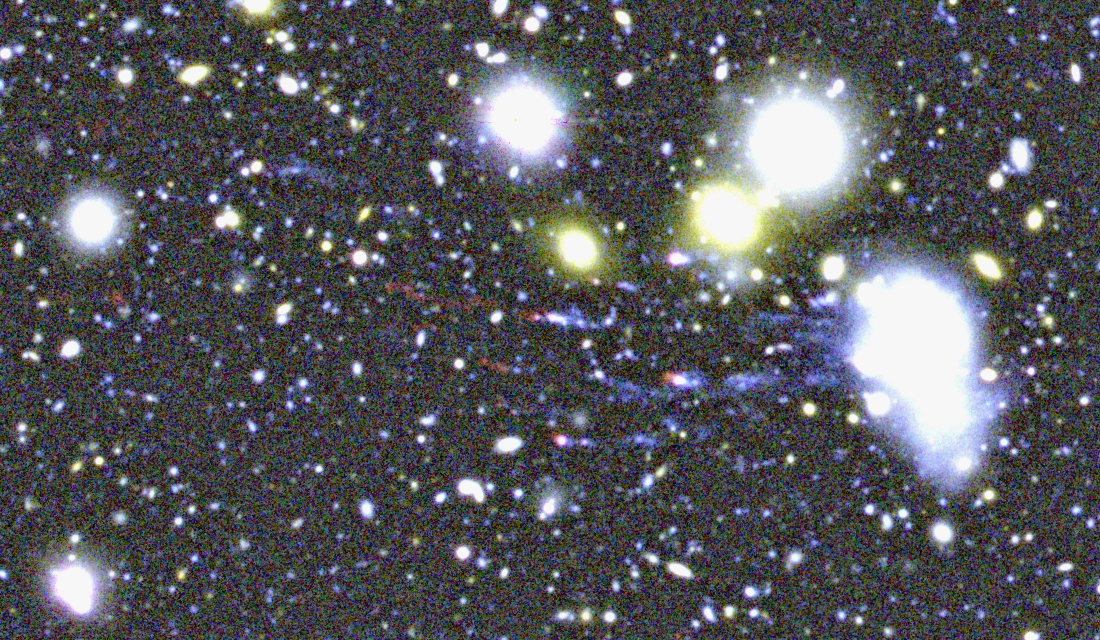[/caption]
During routine observations of the Coma Cluster of galaxies using the Subaru Telescope in Hawaii, astronomers discovered a thread-like structure stretching from one of the galaxies. The astronomers determined this filament was about 260 thousand light years long, and spectral analysis of the filament suggested a younger age toward the outer edge of the filament. The filament also has many young stars surrounded by ionized gas that look like projectiles flying out from the galaxy. So what happened in this chaotic area of space? Astronomers determined a speeding galaxy rammed into the Coma Cluster, stripping gas from the galaxy and creating fireball-like projectiles.
Galaxies evolve over time, and astronomers do not yet understanding how they change in shape, size, and color. Galaxy Clusters, which are dense populations of galaxies, rich with hot intergalactic gas, accompanied by strong gravitational forces are some of the best locations to observe galactic evolution.
A team of researchers from the National Astronomical Observatory of Japan and the University of Tokyo used Suprime-cam on the Subaru Telescope to observe the Coma Cluster of galaxies. The Coma Cluster contains over 1,000 galaxies and is fairly close to Earth at about 300 million light years away.
During observations in 2006 and 2007, the astronomers saw the filament extending from Galaxy RB199 and several of the “fireballs.” Detailed study identified several bright knots connected by blue filamentary structures, and the knots are actually the clusters of young stars weighing 10 million times our Sun, contained in an area about 3000 to 6000 light years across. Because the knots are accompanied by ionized gas, active star formation is going on in the fireballs where usually far less star formation would be expected. The team noted that the size and the mass of the fireballs indicate they could develop into dwarf galaxies.

Because the inside of the cluster is crowded with galaxies, they pass by each other and crash into each other. The team thought that the tidal forces during such encounters could strip gas or stars from the galaxies. They also postulated that as a galaxy falls into the center of the cluster the gravitational forces of the cluster could remove the gas and stars from that galaxy. Both scenarios are possible, however, the research team found that these mechanisms could hardly explain the characteristics of the fireballs. The team then realized that ram pressure stripping occurs when superheated gas (several tens of million Kelvin) in the cluster and the galaxies collide at high speeds. Previous X-ray observation shows the presence of large amounts of hot ionized gas in the middle of the Coma Cluster while RB199 crashes into the center at a speed of 1200 miles per second, causing strong friction with this hot gas. As such, the team concluded that the ram pressure has enough power to strip the gas from the galaxy AND create the fireballs.
While there are several reports indicating ram pressure stripping in nearby galaxy clusters, the identification of fireballs in this study is the first to demonstrate the stripped gas turns into stars while traveling through remote space far away from its source. Similar phenomena have been observed in galaxy clusters much further away at several billions light years, however, those distant cases were interpreted through witnessing the transitional phase of galaxies changing their morphology or colors as they fall into a cluster. The fireballs discovered by this team of Japanese astronomers provide the first sample of such structures in a nearby cluster. Principal investigator, Dr. Michitoshi Yoshida, said “the team is confident that our study of these phenomena leads to a better understanding of the gas stripping processes in galaxy clusters, and the effect of clusters on the evolution of individual galaxies”.
Source: Subaru Press release


One wonders what those fireballs would look like in the skies of worlds of stellar systems in any of the galaxies in that cluster. The fireballs might well sterilize nearby worlds — the question is, how near is “nearby”? When Andromedia ultimately collides with the Milky Way in a few million years, that sort of display probably wouldn’t happen, as the masses involved are nothing compared to that of the Coma cluster, which drives the display in the above photographs. But when galactic clusters collide, the energies released are tremendous — as witness previous articles on Universe Today about such collisions — and the results might well include plenty of sterilized or obliterated stellar systems.
How is this fire created with out oxygen in space. Does the colliding gas have a chemical reaction forming oxygen particles or is it something else.
please answer, Im intruigued.
Thanks.